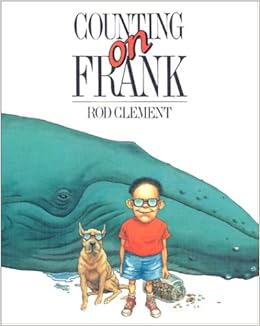Counting on Frank
Posted by Fitore Rexhepi
Title: Counting on Frank
Author and Illustrator: Rod Clement
Common Core State Standards Addressed:
1st Grade:
CCSS.MATH.CONTENT.1.MD.A.2
Express the length of an object as a whole number of length units, by laying multiple copies of a shorter object (the length unit) end to end; understand that the length measurement of an object is the number of same-size length units that span it with no gaps or overlaps. Limit to contexts where the object being measured is spanned by a whole number of length units with no gaps or overlaps.
2nd Grade:
CCSS.MATH.CONTENT.2.OA.A.1
Use addition and subtraction within 100 to solve one- and two-step word problems involving situations of adding to, taking from, putting together, taking apart, and comparing, with unknowns in all positions, e.g., by using drawings and equations with a symbol for the unknown number to represent the problem.1
CCSS.MATH.CONTENT.2.MD.A.1
Measure the length of an object by selecting and using appropriate tools such as rulers, yardsticks, meter sticks, and measuring tapes.
CCSS.MATH.CONTENT.2.MD.A.3
Estimate lengths using units of inches, feet, centimeters, and meters.
3rd Grade:
CCSS.MATH.CONTENT.3.MD.A.1
Tell and write time to the nearest minute and measure time intervals in minutes. Solve word problems involving addition and subtraction of time intervals in minutes, e.g., by representing the problem on a number line diagram.
CCSS.MATH.CONTENT.3.MD.A.2
Measure and estimate liquid volumes and masses of objects using standard units of grams (g), kilograms (kg), and liters (l).1 Add, subtract, multiply, or divide to solve one-step word problems involving masses or volumes that are given in the same units, e.g., by using drawings (such as a beaker with a measurement scale) to represent the problem.2
4th Grade:
CCSS.MATH.CONTENT.4.MD.A.1
Know relative sizes of measurement units within one system of units including km, m, cm; kg, g; lb, oz.; l, ml; hr, min, sec. Within a single system of measurement, express measurements in a larger unit in terms of a smaller unit. Record measurement equivalents in a two-column table. For example, know that 1 ft is 12 times as long as 1 in. Express the length of a 4 ft snake as 48 in. Generate a conversion table for feet and inches listing the number pairs (1, 12), (2, 24), (3, 36), …
CCSS.MATH.CONTENT.4.MD.A.2
Use the four operations to solve word problems involving distances, intervals of time, liquid volumes, masses of objects, and money, including problems involving simple fractions or decimals, and problems that require expressing measurements given in a larger unit in terms of a smaller unit. Represent measurement quantities using diagrams such as number line diagrams that feature a measurement scale.
5th Grade:
CCSS.MATH.CONTENT.5.MD.C.3
Recognize volume as an attribute of solid figures and understand concepts of volume measurement.
CCSS.MATH.CONTENT.5.MD.C.5
Relate volume to the operations of multiplication and addition and solve real world and mathematical problems involving volume.
Common Core State Standards for Mathematical Practice:
CCSS.MATH.PRACTICE.MP1 Make sense of problems and persevere in solving them.
CCSS.MATH.PRACTICE.MP2 Reason abstractly and quantitatively.
CCSS.MATH.PRACTICE.MP4 Model with mathematics.
CCSS.MATH.PRACTICE.MP5 Use appropriate tools strategically.
CCSS.MATH.PRACTICE.MP6 Attend to precision.
Summary:
Counting on Frank is about a curious boy who imagines silly scenarios that require the use of math. For example, he wonders how many humpback whales could fit inside his house or how long it would take for his entire bathroom to fill up with water. The story ends when he wins a family trip to Hawaii for correctly guessing how many jellybeans were inside a jar; an easy task for him! The story is fun and imaginative. It is told from the first person and reads like other popular children's books (i.e. Alexander and the no good…). The book teaches about the real world use of mathematics. It teaches measurement, estimation, multiplication, and addition.
Rating: ***** (5 stars)
I gave this book 5 stars because I think it is a fun read for all ages. The character is likable. The book gets the readers to “use their brains” by thinking about math and the scenarios presented.
Classroom Ideas:
I would use this book differently depending on the age group but I think it could be read to children as young as pre-kindergarten. In pre-k through the second grade, I would read this book to introduce the concepts of measurement and volume.
- I would allow students to discuss, question, and imagine fun scenarios like those presented in the book. As a class, we would measure the walls of the classroom to calculate the length or the height of the classroom. Using cut outs/tracings of students, we could see how many first graders do we need to reach the ceiling?
- A simplified addition example from the book could be to count how many marbles or jelly beans fit inside a jar. After measuring and counting on their own with cubes or other manipulatives, it would be fun to have students guess the amount and win a jar of candy.
In older elementary grades, I would use this book to illustrate the concept of measurement of volume. Some ideas after reading the book to the class:
- In their own small group, students tackle a problem from the book after I first model one with the class. For example, how large of a box would be needed to hold a humpback whale. Then, students could create their own mathematical problems similar to those in the book and solve.
- After the teacher demonstrates how to measure volume of an object by counting cubes, students will measure on their own in pairs or small groups. Once students have a chance to discover how volume is measured on their own using cubes or rulers, they can move on to more examples.
- After reading this book, students will explore the formula for volume and how it can be used to find the volume of familiar spaces like the classroom/closets (measuring themselves), or auditorium/school yard (given measurements).











